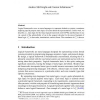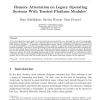ENTCS
2008
14 years 15 days ago
2008
The interactive theorem prover developed in the KeY project, which implements a sequent calculus for JavaCard Dynamic Logic (JavaCardDL) is based on taclets. Taclets are lightweig...
ENTCS
2008
14 years 15 days ago
2008
We report our experience with exploring a new point in the design space for formal reasoning systems: the development of the programming language mega. mega is intended as both a ...
ENTCS
2008
14 years 15 days ago
2008
Thanks to recent advances, modern proof assistants now enable verification of realistic sequential programs. However, regarding the concurrency paradigm, previous work essentially...
ENTCS
2008
14 years 15 days ago
2008
Normalization for the simply-typed -calculus is proven in Twelf, an implementation of the Edinburgh Logical Framework. Since due to proof-theoretical restrictions Twelf Tait'...
ENTCS
2008
14 years 15 days ago
2008
Logical frameworks serve as meta-languages to represent deductive systems, sometimes requiring special purpose meta logics to reason about the representations. In this work, we de...
ENTCS
2008
14 years 15 days ago
2008
CLF (the Concurrent Logical Framework) is a language for specifying and reasoning about concurrent systems. Its most significant feature is the first-class representation of concu...
ENTCS
2008
14 years 15 days ago
2008
The type theory P corresponds to the logical framework LF. In this paper we present H, a variant of P where convertibility is not implemented by means of the customary conversion ...
ENTCS
2008
14 years 15 days ago
2008
State-of-the-art security mechanisms are often enforced in isolation from each other, which limits the kinds of policies that can be enforced in distributed and heterogeneous sett...
ENTCS
2008
14 years 15 days ago
2008
The ability to enforce usage policies attached to data in a fine grained manner requires that the system be able to trace and control the flow of information within it. This paper...
ENTCS
2008
14 years 15 days ago
2008
A lot of progress has been made to secure network communication, e.g., through the use of cryptographic algorithms. However, this offers only a partial solution as long as the com...




